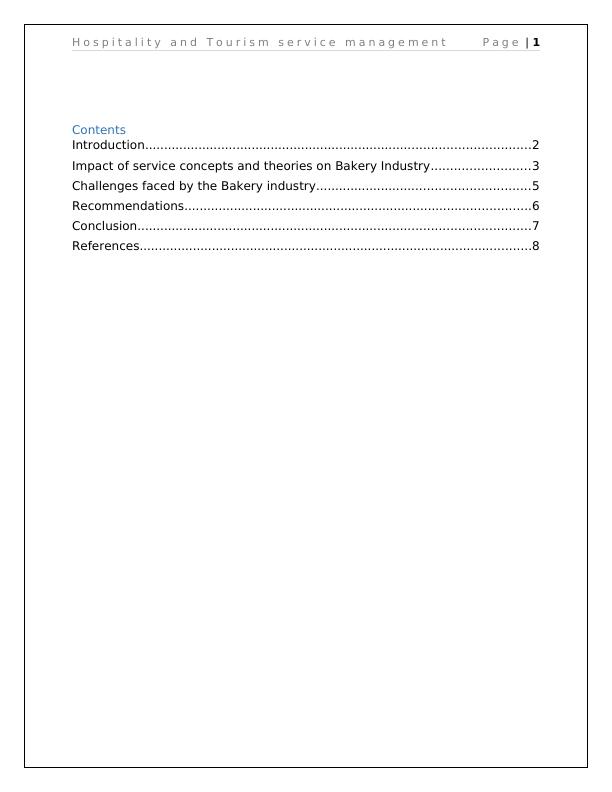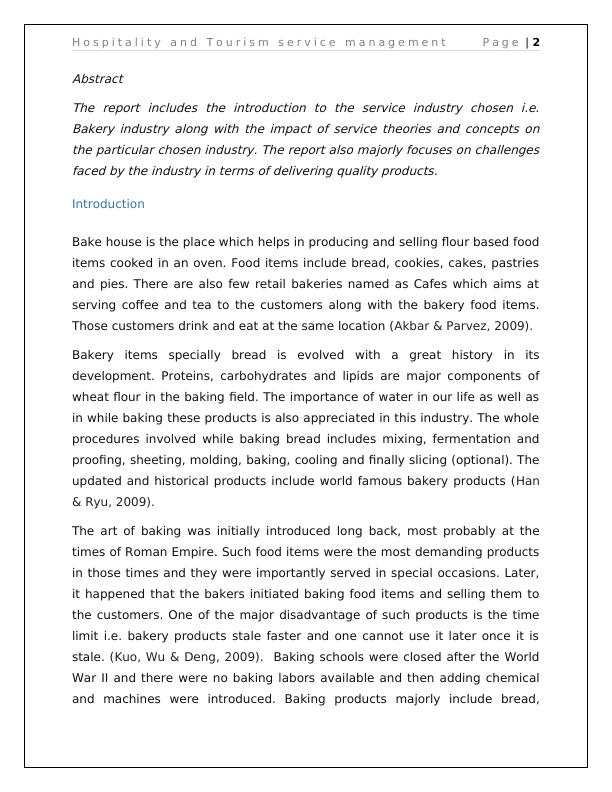Impact of Service Concepts and Theories on Bakery Industry
Added on 2022-12-29
14 Pages3805 Words93 Views
MARKETING
Hospitality and Tourism service management
Hospitality and Tourism service management

H o s p i t a l i t y a n d T o u r i s m s e r v i c e m a n a g e m e n t P a g e | 1
Contents
Introduction.....................................................................................................2
Impact of service concepts and theories on Bakery Industry..........................3
Challenges faced by the Bakery industry........................................................5
Recommendations...........................................................................................6
Conclusion.......................................................................................................7
References.......................................................................................................8
Contents
Introduction.....................................................................................................2
Impact of service concepts and theories on Bakery Industry..........................3
Challenges faced by the Bakery industry........................................................5
Recommendations...........................................................................................6
Conclusion.......................................................................................................7
References.......................................................................................................8

H o s p i t a l i t y a n d T o u r i s m s e r v i c e m a n a g e m e n t P a g e | 2
Abstract
The report includes the introduction to the service industry chosen i.e.
Bakery industry along with the impact of service theories and concepts on
the particular chosen industry. The report also majorly focuses on challenges
faced by the industry in terms of delivering quality products.
Introduction
Bake house is the place which helps in producing and selling flour based food
items cooked in an oven. Food items include bread, cookies, cakes, pastries
and pies. There are also few retail bakeries named as Cafes which aims at
serving coffee and tea to the customers along with the bakery food items.
Those customers drink and eat at the same location (Akbar & Parvez, 2009).
Bakery items specially bread is evolved with a great history in its
development. Proteins, carbohydrates and lipids are major components of
wheat flour in the baking field. The importance of water in our life as well as
in while baking these products is also appreciated in this industry. The whole
procedures involved while baking bread includes mixing, fermentation and
proofing, sheeting, molding, baking, cooling and finally slicing (optional). The
updated and historical products include world famous bakery products (Han
& Ryu, 2009).
The art of baking was initially introduced long back, most probably at the
times of Roman Empire. Such food items were the most demanding products
in those times and they were importantly served in special occasions. Later,
it happened that the bakers initiated baking food items and selling them to
the customers. One of the major disadvantage of such products is the time
limit i.e. bakery products stale faster and one cannot use it later once it is
stale. (Kuo, Wu & Deng, 2009). Baking schools were closed after the World
War II and there were no baking labors available and then adding chemical
and machines were introduced. Baking products majorly include bread,
Abstract
The report includes the introduction to the service industry chosen i.e.
Bakery industry along with the impact of service theories and concepts on
the particular chosen industry. The report also majorly focuses on challenges
faced by the industry in terms of delivering quality products.
Introduction
Bake house is the place which helps in producing and selling flour based food
items cooked in an oven. Food items include bread, cookies, cakes, pastries
and pies. There are also few retail bakeries named as Cafes which aims at
serving coffee and tea to the customers along with the bakery food items.
Those customers drink and eat at the same location (Akbar & Parvez, 2009).
Bakery items specially bread is evolved with a great history in its
development. Proteins, carbohydrates and lipids are major components of
wheat flour in the baking field. The importance of water in our life as well as
in while baking these products is also appreciated in this industry. The whole
procedures involved while baking bread includes mixing, fermentation and
proofing, sheeting, molding, baking, cooling and finally slicing (optional). The
updated and historical products include world famous bakery products (Han
& Ryu, 2009).
The art of baking was initially introduced long back, most probably at the
times of Roman Empire. Such food items were the most demanding products
in those times and they were importantly served in special occasions. Later,
it happened that the bakers initiated baking food items and selling them to
the customers. One of the major disadvantage of such products is the time
limit i.e. bakery products stale faster and one cannot use it later once it is
stale. (Kuo, Wu & Deng, 2009). Baking schools were closed after the World
War II and there were no baking labors available and then adding chemical
and machines were introduced. Baking products majorly include bread,

H o s p i t a l i t y a n d T o u r i s m s e r v i c e m a n a g e m e n t P a g e | 3
bread roll, flat breads, bagels, doughnuts, muffins, pizzas, buns, pies
pastries, cupcakes, scones, soda bread, biscuits, cookies, cakes, brownies,
pita, potato bread, pumpkin bread, corn bread, pretzels and many more (Hu
et al., 2009).
There are few bakeries who only deliver products on occasions like wedding,
birthday party, anniversary, and some formal events. Those people who have
allergies to nuts, peanuts and gluten can easily have bakery food items.
Some bakery focuses on providing traditional bread which do not contain any
bleaching materials and which is wholly made up of locally milled flour
(Trienekens & Zuurbier, 2008). The market segments of bakery products are
shown below.
Bread: 32 percent
Rolls: 19 percent
Cakes: 15 percent
Retail bakery products: 10 percent
Soft cakes: 8 percent
Pies: 2 percent.
Stores and supermarkets aims at selling packaged breads and cakes and
there are few stores which aims at selling in store baking facilities to the
customers. By the year 2021, sales of in store bakery food items will create a
rapid change and growth in an average of 2.2% per year with an estimation
of $16.3 billion. Dependent on the upcoming trends and demands, bakery
industry will have an ongoing growth majorly for those people who focuses
on health, sales and flavor (Hess & Hess, 2017). The baking industry
develops higher than $30 billion every year and incudes nearly 6000 retail
bakeries along with 3000 commercial bakery stores. Grupo Bimbo, Flowers
Foods and Campbell Soup Co. are the major three producers of small retail
bread roll, flat breads, bagels, doughnuts, muffins, pizzas, buns, pies
pastries, cupcakes, scones, soda bread, biscuits, cookies, cakes, brownies,
pita, potato bread, pumpkin bread, corn bread, pretzels and many more (Hu
et al., 2009).
There are few bakeries who only deliver products on occasions like wedding,
birthday party, anniversary, and some formal events. Those people who have
allergies to nuts, peanuts and gluten can easily have bakery food items.
Some bakery focuses on providing traditional bread which do not contain any
bleaching materials and which is wholly made up of locally milled flour
(Trienekens & Zuurbier, 2008). The market segments of bakery products are
shown below.
Bread: 32 percent
Rolls: 19 percent
Cakes: 15 percent
Retail bakery products: 10 percent
Soft cakes: 8 percent
Pies: 2 percent.
Stores and supermarkets aims at selling packaged breads and cakes and
there are few stores which aims at selling in store baking facilities to the
customers. By the year 2021, sales of in store bakery food items will create a
rapid change and growth in an average of 2.2% per year with an estimation
of $16.3 billion. Dependent on the upcoming trends and demands, bakery
industry will have an ongoing growth majorly for those people who focuses
on health, sales and flavor (Hess & Hess, 2017). The baking industry
develops higher than $30 billion every year and incudes nearly 6000 retail
bakeries along with 3000 commercial bakery stores. Grupo Bimbo, Flowers
Foods and Campbell Soup Co. are the major three producers of small retail

End of preview
Want to access all the pages? Upload your documents or become a member.
Related Documents
International Marketing Group Projectlg...
|11
|2539
|34
Literature Review on Bakery Businesslg...
|11
|3425
|90
Strategic Information System for B Bakery: System Requirements and Software Selectionlg...
|16
|3977
|246
Crafting Your Future: Professional Practice and Researchlg...
|17
|4966
|68
The Context of Businesslg...
|7
|1726
|435
cw1lg...
|9
|1875
|85